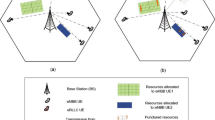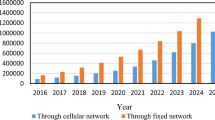Abstract
The battery endurance of the user equipment device is enhanced by using discontinuous reception mechanism (DRX) in the long term evolution (LTE) networks. Configuring the DRX parameters for the power savings increases the packet loss ratio (PLR). Moreover, the increased PLR due to the delay bound violation by the DRX configuration severely affects the quality of service (QoS) for the bearer service users. Hence, the reduction in PLR and maintaining the QoS with optimized power savings provides a challenging task. In this work, an attempt has been made to analyse the PLR performance of LTE device by incorporating the on timer to short cycle (OTSC) ratio ‘α’ based power saving DRX mechanism approach on 3 state and 4 state Markov model. The QoS related issues are addressed by using the above mentioned proposed model. The European Telecommunications Standards Institute traffic pattern is adopted for the PLR analysis of OTSC based power saving DRX mechanism. The simulation is done by using MATLAB. The simulation results reveal that an improvement in the reduction of the PLR using proposed method is achieved compared to that of the existing regenerative cycle method. The analyses exhibits that by assigning α = 0.0625, proposed method achieves 14% of reduction in PLR for DRX long cycle of 512 ms, 45% of reduction in PLR for DRX short cycle timer and 19.6% reduction for100 ms of inactivity timer than that of existing method. Further the proposed method obtains 12.45% of reduction in the PLR at buffer packet size of 150 ms compared to that of existing method.










Similar content being viewed by others
References
3GPP. Requirements for evolved UTRA (E-UTRA) and evolved UTRAN (E-UTRAN). http://www.3gpp.org.
Yang, S. R., & Lin, S. B. (2005). Modeling UMTS discontinuous reception mechanism. IEEE Transaction on Wireless Communications, 4(1), 312–319.
Yang, S. R., Yan, S., & Hung, H. N. (2007). Modeling UMTS power saving with bursty packet data traffic. IEEE Transaction on Mobile Computing, 6(12), 1398–1409.
ETSI technical report UMTS 30.03 version 3.2.0: Universal Mobile Telecommunications System (UMTS): Selection procedures for the choice of radio transmission technologies of the umts.
Huang, J., Qian, F., Gerber, A., Mao, Z. M., Sen, S., & Spatscheck, O. (2012). A close examination of performance and power characteristics of 4G LTE networks. In Proceedings of ACM, Ambleside, UK (pp. 225–238).
Zhou, L., Xu, H., Tian, H., Gao, Y., Du, L., & Chen, L. (2008). Performance analysis of power saving mechanism with adjustable DRX cycles in 3GPP LTE. In Proceedings of IEEE 68th vehicular technology conference, Calgary, BC (pp. 1–5).
Koc, Ali T., Jha, Satish C., Vannithamby, Rath, & Torlak, Murat. (2014). Device power saving and latency optimization in LTE-A networks through DRX configuration. IEEE Transaction On Wireless Communications, 13(5), 2614–2625.
Kolding, T. E., Wigard, J., & Dalsgaard, L. (2009). Balancing power saving and single user experience with discontinuous reception in LTE. In Proceedings of IEEE international symposium on wireless communication systems (ISWCS’09), Siena-Tuscany, Italy (pp. 713–717).
Varma, S. R., Krishna, M., Sivalingam, S., Tung, L., & Lin, Y. (2015). Analytical model for power savings in LTE networks using DRX mechanism. In proceedings of IEEE 21st national conference on communications, Mumbai, India (pp. 1–6).
Kim, S., Jung, K., Choii, J., & Kwak, Y. (2014). Improving LTE/LTE-A UE power efficiency with extended DRX Cycle. In proceedings of IEEE 80th vehicular technology conference, Vancouvaer, BC (pp. 1–5).
Yang, C. C., Mai, Y. T., Chen, J. Y., & Kuo, Y. C. (2014). LBPS: Load based power saving in the IEEE 802.16e network. Computers & Electrical Engineering, 38(4), 91–95.
Yang, C. C., Mai, Y. T., Chen, J. Y., & Kuo, Y. C. (2015). Integrated load based power saving for BS and MSS. IEEE 802.16e network. Wireless Communications and Mobile Computing, 15(4), 601–614.
Yang, C. C., Chen, J. Y., Mai, Y. T. & Liang, C. H. (2014). Design of a load based DRX scheme for non-real-time traffic in LTE. In Proceedings of the international multiconference of engineers and computer scientists, Hong Kong (pp. 197–200).
Lee, T. H., Tsai, C. J., & Wu, T. H. (2013). Quality of service support under DRX mechanism in LTE advanced wireless networks. In Proceedings of the IEEE 77th vehicular technology conference, Dresden (pp. 1–5).
Radhakrishnan, S., Neduncheliyan, S., & Thyagharajan, K. K. (2016). A review of downlink packet scheduling algorithms for real time traffic in LTE-advanced networks. Indian Journal of Science and technology, 9(4), 1–4.
Vassoudevan, R., & Samundiswary, P. (2016). Performance analysis of LTE device using OTSC ratio for delay bound violated traffic. In Proceedings of IEEE international conference on wireless communications, signal processing and networking, Chennai, India (pp. 38–42).
Kumar, K. T. V., Vassoudevan, R., & Samundiswary, P. (2015). Performance evaluation for LTE using 4 state discontinuous reception (DRX) mechanism with on time to short cycle (OTSC) ratio. In Proceedings of IEEE international conference on control, instrumentation, communication and computational technologies, Kumarakoil, India (pp. 451–456).
Vassoudevan, R., & Samundiswary, P. (2016). Power efficiency analysis of four state Markov model based DRX mechanism with OTSC ratio for long term evolution user equipment. Special Issue—International Journal of Computer Science and Information Security, 14, 77–83.
Vassoudevan, R., & Samundiswary, P. (2016). Quantitative analysis on quality of service support using OTSC-DRX mechansim in long term evolution device. Indian Journal of Science and Technology, 9(43), 1–7. doi:10.17485/ijst/2016/v9i43/102871.
Fowler, S. A., Mellou, A., & Yamada, N. (2013). LTE-Advanced DRX Mechansim for Power Savings. ISTE & Wiley Publishers, Hoboken, USA.
Author information
Authors and Affiliations
Corresponding author
Rights and permissions
About this article
Cite this article
Ramachandiran, V., Punniakodi, S. QoS Support Analysis of LTE Device Using Four State Markov Model Based DRX with OTSC for Power Efficient Bearer Services. Wireless Pers Commun 98, 2673–2691 (2018). https://doi.org/10.1007/s11277-017-4994-5
Published:
Issue Date:
DOI: https://doi.org/10.1007/s11277-017-4994-5




